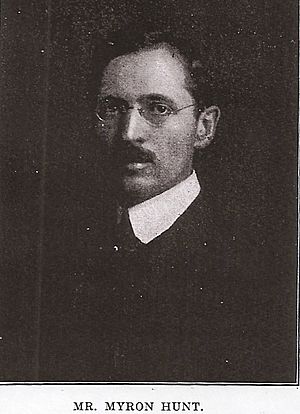Myron Hunt facts for kids
Quick facts for kids
Myron Hunt
|
|
|---|---|
 |
|
| Born | February 27, 1868 |
| Died | May 26, 1952 (aged 84) |
| Nationality | American |
| Alma mater | Massachusetts Institute of Technology (B.S., Architecture, 1893) |
| Occupation | Architect |
| Buildings | Huntington Art Gallery Ambassador Hotel Rose Bowl |
Myron Hubbard Hunt (born February 27, 1868, died May 26, 1952) was a famous American architect. He designed many well-known buildings, especially in Southern California and Evanston, Illinois. In 1908, he became a Fellow of the American Institute of Architects. This is a special honor for architects.
Contents
Early Life and Learning
Myron Hunt was born in Sunderland, Massachusetts. His family later moved to Chicago. There, he went to Lake View High School.
From 1888 to 1890, he studied at Northwestern University. Then, he went back to Massachusetts. He studied at MIT from 1890 to 1893. He earned a degree in Architecture from MIT in 1893. After school, he spent three years traveling in Europe. When he returned, he worked as a draftsman in an architecture firm in Evanston.
Myron Hunt married Harriette Boardman. Their son, Robert Hunt, became a poet.
Designing Buildings
Myron Hunt was an early member of the "Prairie School" group of architects in Chicago. But in 1903, he moved to Los Angeles. There, he started a partnership with another architect, Elmer Grey. Their firm, Hunt and Grey, opened an office in Pasadena, California.
Wealthy people in Pasadena liked their designs. They hired Hunt and Grey to build many large, expensive homes. Some of their work was even shown in Architectural Record, a national magazine. Soon, they were designing bigger projects. These included hospitals, schools, churches, and hotels.
Designing for Schools
Hunt and Grey designed buildings for Throop Institute in Pasadena. This school later became the California Institute of Technology. In 1911, they started planning the new campus for Occidental College. Hunt continued to be the main architect for Occidental's buildings until 1940.
They also worked with Pomona College. In 1908, Hunt and Grey created a plan for the college's expansion. Hunt also designed a concert hall there, called Bridges Hall of Music, in 1915. This building is considered one of Hunt's best works.

Hotels and Resorts
In 1913, Hunt and Grey designed a new part for The Mission Inn in Riverside, California. Over the next ten years, they designed, remodeled, or expanded many hotels. Their biggest hotel project was the Ambassador Hotel in Los Angeles. It opened in 1921.
Hunt also redesigned the Wentworth Hotel in Pasadena. This hotel was bought by Henry E. Huntington in 1911. Hunt rebuilt it, and it reopened as the Huntington Hotel in 1914. It became Pasadena's most important hotel for many years. In 1921, he also turned the Vista Hotel into a top resort. He designed several of its original bungalows.
Working with Henry Huntington
Hunt and Grey started working with Henry Huntington in 1909. They designed his house in San Marino, California. Later, a large addition was built in 1934. This house became the main art gallery for the Huntington Library, a famous cultural center. Later in his career, Hunt designed a new main building for the Huntington Memorial Hospital, which was named after Huntington.
Other Famous Projects
Another famous Pasadena landmark designed by Hunt is the Rose Bowl. This stadium is well-known for its football games and events.
In 1927, Hunt designed a hotel for Senator Frank P. Flint. This hotel was later sold and became Flintridge Sacred Heart Academy. This is a high school for girls.
By 1912, Myron Hunt had started a new firm with architect Harold C. Chambers. In this partnership, Hunt designed several libraries in California. These include libraries in Redlands, Palos Verdes Estates, and Santa Barbara. He also designed the Pasadena Central Library. This library is one of the three main buildings in the Pasadena Civic Center District.
In 1913, he designed a building for the Standard Oil Company in Los Angeles. This building was later used as a storage facility. From 1975 to 1991, it was home to a feminist art center called the Woman's Building. The building is a great example of Beaux Arts architecture.
Myron Hunt retired to Port Hueneme, California. He died there in 1952.
Images for kids



